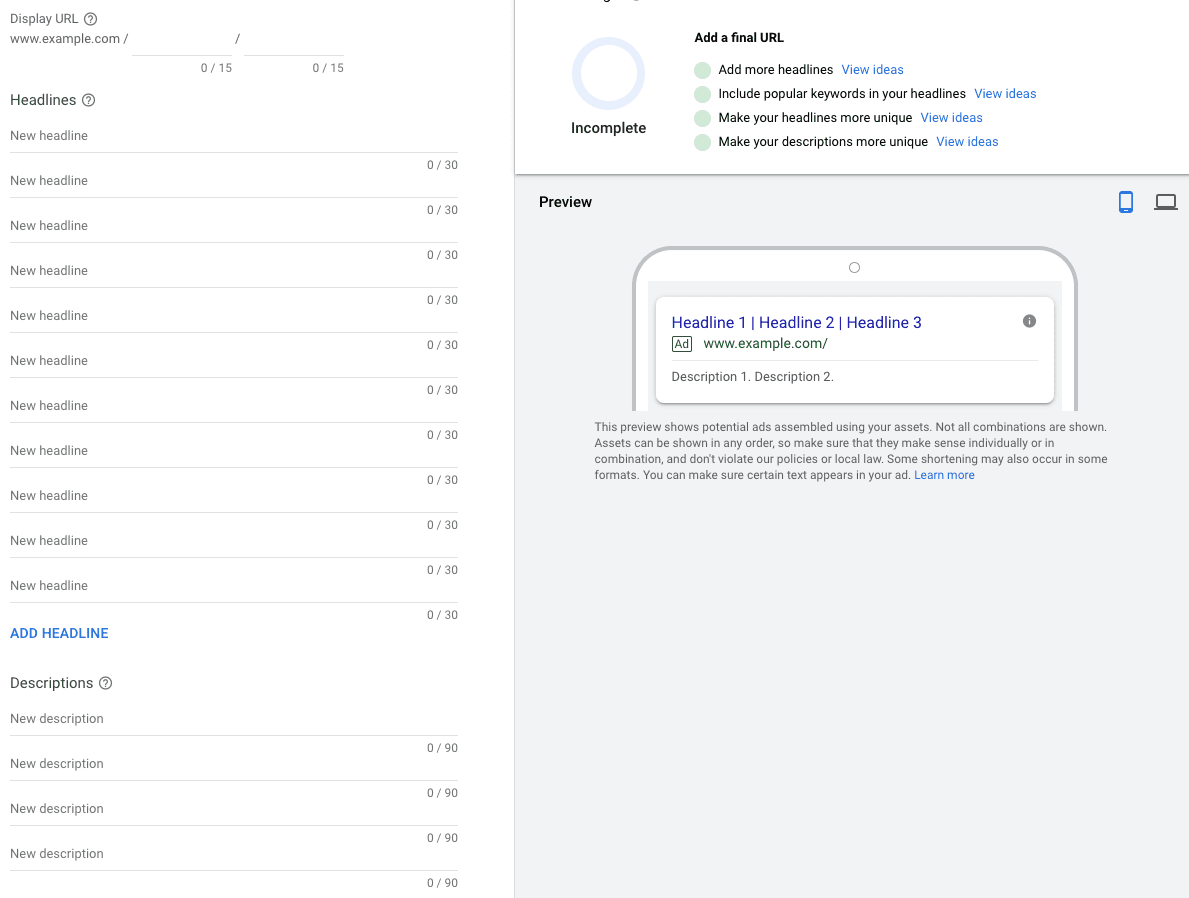Last May, we discussed in length Google’s new search feature, Responsive Search Ads. At the time when the blog was written, the ads were still in beta testing. Now, let’s take a moment to look back and update our initial findings.
What are Responsive Search Ads?
Responsive search ads differ from traditional text ads. These ads allow marketers to write up to 15 different headlines and 4 descriptions.
Google uses machine learning to test out different combinations and then optimize the ads with the best performing versions.
As we mentioned in our original blog, Google can arrange your ads in 43,680 different permutations, resulting in nearly endless ad testing opportunities.

One of the biggest selling points of Responsive Search Ads is that digital marketers no longer need to manually A/B test different combinations because Google’s algorithm will do it for you.
However, since you don’t have control over the combinations, it is important that your ad copy be diverse and interchangeable. If you have multiple descriptions or headlines that have similar wording, there is a possibility your audience will be served redundant ads.
If you want more control over your ads, Google allows you to pin headlines and descriptions in a particular order. However, this does limit Google’s ability to test and optimize the different combinations, which is why Google does not recommend this. It is estimated that pinning a single headline reduces the amount of testing Google can perform on these ads by over 75%.

This feature is especially important when it comes to ensuring brand name appears in every headline.
For example, say you are on Coca-Cola’s marketing team and running a holiday-themed Responsive Search campaign with headline options such as ‘Spice Up The Season,’ ‘Coca Cola,’ and ‘Celebrate the Holidays.’ It could be possible that some ads are displayed without the brand name in any of the headlines.
Over time, Google’s AI will test out these combinations and learn which headlines make up the top-performing ads, but it’s helpful to have the ability to pin in the meantime.
Why I Use Them
Whenever I make a new search campaign in Google Ads, I always make multiple variations of traditional Expanded Text Ads and include one Responsive Search Ad in each ad group.
While I tend to prefer having total control over all the combinations, in almost every instance my Responsive Search Ads have proven to receive higher clicks, click-through rates, and more conversions than my Expanded Text Ads.
I recommend that advertisers use both Responsive Search Ads and traditional text ads because this will allow your ads to appear as often as possible. Google stated that RSA should not replace text ads, but should be viewed as complementary to them. For best results, run at least 3 Expanded Text Ads and 1 Responsive Search Ad in every ad group.

Benefits of Using Responsive Search Ads
Last May, we discussed our initial thoughts and first impressions, but now we’ve had more time to dig in. Below are three of Google’s claims regarding the advantages of implementing RSA and our thoughts on said claims:
- Improve performance – Google has reported that Responsive Search Ads have a 5%-15% higher CTR compared to traditional search ads. There are no updated stats out about this yet, and from my own experience, this is true.
- Save time – If you have already written your ad copy, it takes a lot less time to set up RSA than ETA because you don’t need to spend time thinking about what combinations will work best together. Also, because it takes a lot of time to analyze the performance of ads, write new copy, and make necessary adjustments, this ad format saves time by automatically optimizing your ads. However, it is best practice to run both ads alongside each other, so it does add one simple additional step to a digital marketer’s workflow.
- Experiment with new ideas – RSA gives you the opportunity to experiment with ideas you would otherwise not want to waste time and money testing out. If these new ideas don’t work, you can rest easy knowing that Google will not show them. I love this feature because I can get creative and try out new ideas without the fear of wasting the budget.
Best Practices to Keep in Mind
- Use extensions – Don’t forget to add extensions to your ads! Extensions provide your audience additional information, such as linking to specific website pages, location information, call buttons, etc. They are also proven to increase click-through rates by several percentage points.
- Vary your headlines and descriptions – Don’t be afraid to get creative and test out different variations! Highlight different offers, call-to-actions, and value propositions to see what works best. To get the most out of your ads, make sure to include some headlines with and without keywords. Test out different text lengths, too.
- Take advantage of the number of headlines and descriptions! The more headlines and descriptions you add, the better the chance of success you have! This is an optimal time to test out new ideas.
TL;DR
Responsive Search Ads give users the option to write up to 15 different headlines and 4 descriptions. These ads help Google’s AI to test, learn, and finally run the optimized, best-performing combinations. So is it time to start using them? Yes! Marketing is tests different strategies to see what works best for you, so it is definitely worth trying them out! It’s important to remember Responsive Search Ads should should be viewed as complementary to each other!
-FINAL(01-00)-White&Blue-01.svg)




